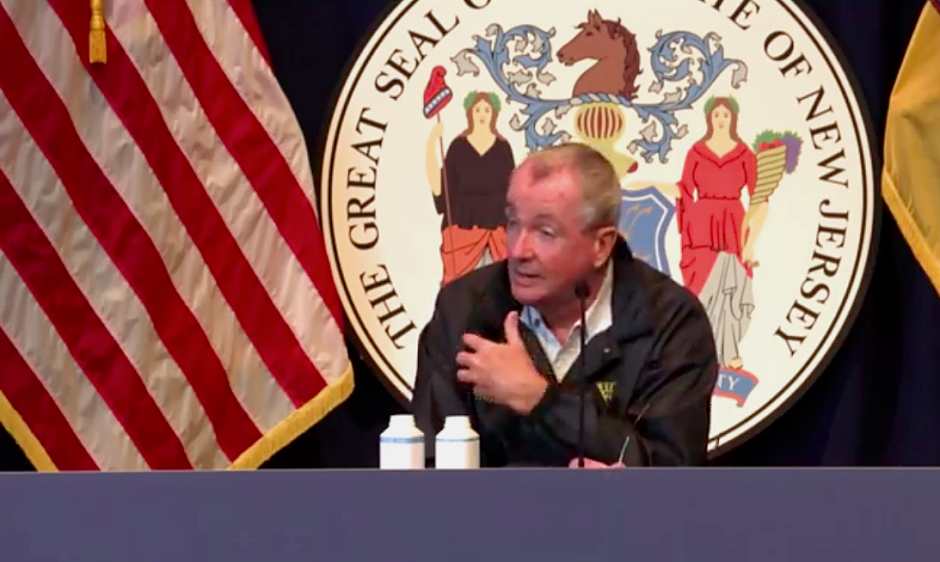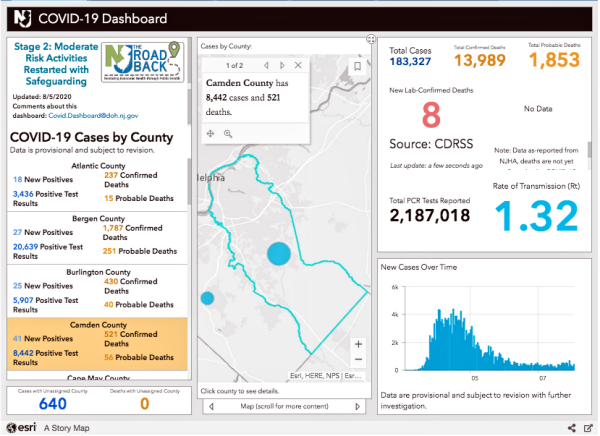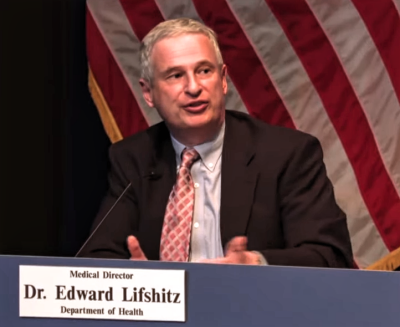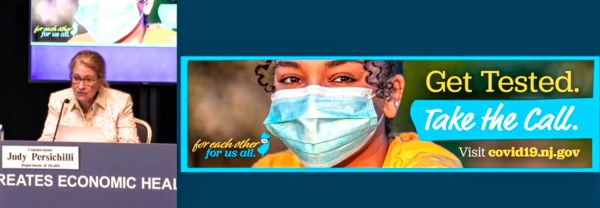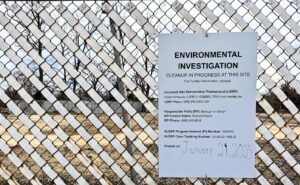Plus: why New Jersey isn’t close to achieving herd immunity, and why the increase in positive cases concerns health officials more than the encouraging numbers from hospitals.
By Katrina Janco | August 5, 2020
Another 378 New Jersey residents have tested positive for novel coronavirus (COVID-19), bringing the statewide total to 183,327 cases, Governor Phil Murphy reported Wednesday.
National demand for the reagents used in COVID-19 tests is delaying turnaround of laboratory results; however, Murphy said that Tuesday’s numbers could be “thrown out the window.”
In addition to the testing delays, power outages across the state prevented hospitals from reporting their COVID-19-related data as well as forcing them to divert patients elsewhere.
Sadly, eight more residents have perished from complications related to the virus, bringing the statewide death toll to 13,989 lives lost during the pandemic.
One, a seven-month-old baby, is the youngest New Jerseyan to test positive for the virus after death. It is unknown whether COVID-19 was the primary cause of the baby’s death, and no additional details were released to protect the family’s privacy, officials said.
In addition to those lab-confirmed fatalities, the state also recognizes another 1,853 probable COVID-19-related deaths, down 22 from the previously reported 1,875.
Throughout New Jersey, 784 people are currently hospitalized with a case of COVID-19: 295 have tested positive for the virus, and 489 are awaiting confirmation of their symptoms.
Among those hospitalized patients, 117 are in intensive or critical care, and 47 ICU and critical-care patients (40 percent) are on ventilators.
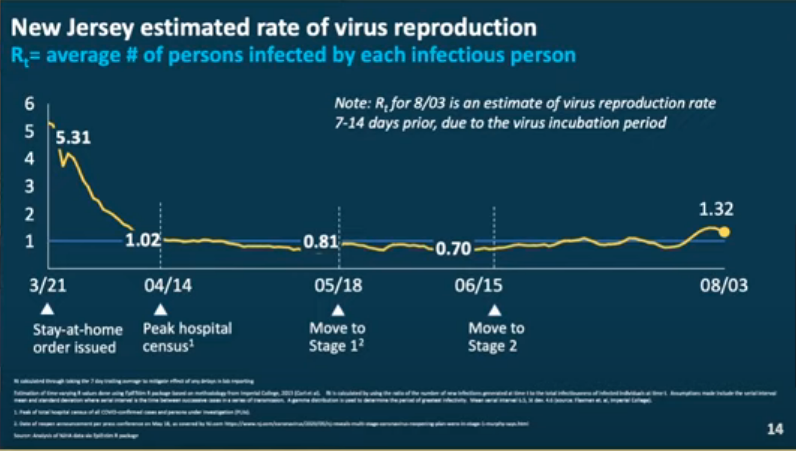
Rt, the rate of transmission of new COVID-19 cases in New Jersey, fell to 1.32 August 3. Credit: NJ Pen.
Rate of transmission (Rt) slightly decreases to 1.32, spot positivity remains highest in South Jersey
The statewide average of COVID-19 spot positivity testing stood at 2.57 percent August 5; in South Jersey, it’s almost a point-and-a-quarter higher, at 3.79 percent.
The higher positivity rate in South Jersey is not due to a lack of testing, said New Jersey Health Commissioner Judy Persichilli: in June, the region led all of New Jersey in testing, at 254 persons per 100,000.
Rt, the variable that describes the rate of transmission of new COVID-19 cases, declined from 1.48 on August 1 to 1.32 from samples taken August 3.
Any Rt figure of more than 1.0 means that each new COVID-19 patient is infecting more than one other person, on average, which means the virus is spreading.
The lowest recorded Rt since the mid-April COVID-19 spike in New Jersey was 0.62, recorded June 9.
Long-term care accounts for half of all deaths, a fifth of those infected
Across New Jersey, 610 long-term care (LTC) centers have reported at least one case of COVID-19, and account for 37,494 infected patients and staff, or 20 percent of total cases.
That includes 24,579 residents and 12,915 staffers sickened by the virus, as well as 6,949 lab-confirmed resident deaths (50 percent of the statewide total) and 119 facility-reported staff deaths.
Of 654 veterans residing in a state-run home, 388 residents have tested positive for COVID-19, and 146 have died from complications related to the virus. Six veterans presently are hospitalized with COVID-19, and 242 have recovered from the virus.
At state-run psychiatric facilities, 213 of 1,221 patients and 509 staff members have tested positive for COVID-19. Thirteen patients and seven staffers have died from complications related to the virus.
To date, 55 New Jersey children aged 1 to 18 have been diagnosed with pediatric multisystem inflammatory syndrome, Persichilli said; no new cases this week.
All have tested positive for an active COVID-19 infection or the presence of COVID-19 antibodies, indicating exposure to the virus. No children are currently hospitalized. No deaths have been associated with this syndrome in New Jersey.
New Jersey “nowhere near” achieving herd immunity
Without knowing for sure how many New Jerseyans would have to survive COVID-19 to create a “herd immunity” to the virus, Dr. Ed Lifshitz, Director of the New Jersey Communicable Disease Service, said estimates put it at 70 to 80 percent of the population.
“At this point, it is clear that we’re at nowhere that high a level,” Lifshitz said.
“Some people are likely immune, but nowhere near that number,” he said.
Moreover, Lifshitz said that the current trajectory of the virus within New Jersey—fewer hospitalizations and deaths, yet increasing numbers of positive cases—”is almost assuredly a combination of a number of factors.”
Deaths and hospitalizations are lagging indicators of an infection that now is spreading among a younger population of infected persons, he said.
Many younger people who contract COVID-19 don’t require hospitalization to defeat the virus, and do not die from it. However, “they are still often infecting others, who then, down the road, become ill, and those bad outcomes may happen,” Lifshitz said.
“For the state as a whole, it is very concerning, because those younger people can infect other people,” he said. “We’re always trying to figure out what we might be seeing down the road if this continues.”
‘For Each Other, For Us All’ COVID-19 Public Awareness Campaign
Young people are among those targets of a new ad campaign designed to educate New Jerseyans about the importance of getting tested for COVID-19 and participating in contact tracing.
Entitled, “For each other, for us all,” the campaign “reinforces that we are all in this together,” Persichilli said.
“What one person does or doesn’t do can impact another, and we must all work together to protect not only ourselves, but our families and our community at large, to get through this pandemic,” she said.
The campaign will run throughout the summer, with an emphasis on those deemed most vulnerable to the pandemic, Persichilli said, including: communities of color, frontline workers, seniors, farmworkers, the LGBTQ community, and people younger than 30 “because of the risky behaviors we have seen them engage in.
“When young people gather in crowded spaces without proper precautions, they are putting their loved ones at risk,” the commissioner said.
“They are putting themselves at risk,” she said. “They may affect their parents, grandparents, aunts, and uncles. We need them to get tested and participate in contact tracing to protect the health of our state.”
Persichilli asked residents to share the campaign messages as they make their way across social media; the multi-channel approach will hit television, radio, billboards, and transit and electric signage throughout the state.
Tool kits with messaging in English, Spanish, Arabic, Korean, Cantonese, Mandarin, and Hindi will be distributed to local health departments, state agencies, hospitals, offices of elected officials, at federally qualified health centers, and community groups.

